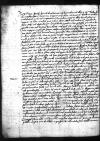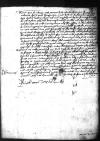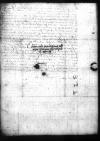Pervenit huc tandem pridie ⌊reverendissimus dominus Strigoniensis archiepiscopus⌋, cui ⌊serenissimus ⌊Austriae⌋ dux⌋ et alii oratores, cum quibus ego fui, ivit in campum usque obviam et eundem honestissime suscepit. Sequenti die ⌊illius dominatio reverendissima⌋ ad honorem Sacrae Maiestatis Vestrae, quam summe in omnibus observat, cum quadam pompa praefectum curiae suae pro me misit, et quia aliquantulum valetudine laborat, a duobus ductus processit contra me et honorifice excepit.
Deinde in conclavi solus cum ⌊illius dominatione reverendissima⌋ occlusus, praefatus prius multa de benevolentia, qua illius dominationem Maiestas Vestra Regia prosequitur, exposui ⌊illi⌋ causam, cur ad serenissimum ⌊archiducem Austriae⌋ atque alios arbitros in causa Prutena essem missus, et quid ad illius dominationem reverendissimam potissimum spectaret. Ob eam fiduciam, quam de eo Maiestas Vestra concepisset, rogabam ⌊dominationem eius reverendissimam⌋, ut cum ceteris arbitris, praesertim cum serenissimo ⌊Ungariae rege⌋ et ⌊archiduce Austriae⌋, cum eam sors huc obtulisset, demum ageret, ut huic tragoediae finis imponeretur. Explicui illi etiam omnia, quae mihi dominus ⌊archidux Austriae⌋ respondisset, quod de loco et tempore cum serenissimo ⌊Hungariae rege⌋, quantum posset celerius, vellet convenire et singula alia, quae in prioribus meis litteris sunt descripta.
Quae postquam diligenter audisset, ut est vir magnae experientiae et in magnis rebus ab unguiculis versatus, in primis super benevolentia, quam apud Sacram Maiestatem Vestram habet, et de sua observantia ac fide, qua Maiestati Vestrae est addictus, commoda oratione respondit. De rebus vero Prutenicis, quasi haerens in quadam deliberatione, sic est exorsus, quod dum perpenderet, in quibus nunc rebus ⌊Ungariae⌋ et ⌊Poloniae⌋ regna constituerentur, et quod ab utrisque Germana natio pro ferendis suppetiis esset rogata, unde nunc erexisset cristas, cum videret, quod illius ope egerent haec regna. Non videretur, neque consultum neque hoc tempore oportunum, quod cum causae Prutenicae decisione deberet accelerari, tamen adhuc indutiarum tres anni restarent, posset interea res istorum duorum regnorum fieri melior, quod Germanae nationis nihil egeret fierentque viribus non inferiora Germanis. Tunc primum negotium Prutenicum commode posset tractari et ad meliores condiciones, quam istis temporibus, perduci. Et quod sibi non placeret, quod ⌊princeps Austriae⌋ cum serenissimo ⌊Ungariae rege⌋ iam de tempore et loco constituisset convenire, quia ⌊magister⌋ ⌊Prussiae⌋ iam haberet in his turbinibus oportunitatem, urgeret et instaret apud omnes, ut hoc tempore in his rebus fierent tractatus. Haec pro sua fide, qua Sacrae Maiestati Vestrae devincitur, se dicere testabatur. Nihilominus quaecumque posse in hac causa, quae commodo et ornamento Maiestati Vestrae cederent, omnem conatum, omnem operam et studium, ut fidelis capellanus Sacrae Maiestatis Vestrae, impendere vellet. Addidit insuper multa alia de ⌊magistro⌋, de ⌊ordine⌋, de ⌊marchionibus⌋, de serenissimo ⌊Ungariae rege⌋, de quo conclusit, quod paulo post oporteret eum aliam pellem induere. In summa videtur mihi Maiestati Vestrae velle plurimum prodesse.
Serenissime Rex, postquam haec ad duas horas super his rebus cum ⌊illius dominatione reverendissima⌋ colloquendo intellexissem, licet sim ingenio et iudicio ut iuvenis hebes et rudis, videbatur mihi non inoportunum consilium, coepi dominationem illius reverendissimam plurimum rogare, ut hoc et alia, quae rebus Sacrae Maiestatis Vestrae viderentur expedire, Sacrae Maiestati Vestrae describeret. Considerans, quod in hoc potissimus punctus legationis meae ad ⌊caesarem⌋ penderet, ad quem est via longa et non bene sine magnis impensis Sacrae Maiestatis Vestrae potest confici. Non quod ego pro Sacra Maiestate Vestra timerem tam spatiosum iter et tot maris et terrae subire discrimina, immo ut prius scripsi, ex quo Deus et Maiestas Vestra vult, quod in his rebus verser, si etiam vita sit ponenda, impigre et fideliter omnia, quae mihi Sacra Maiestas Vestra iniunxit, acturus sum. Nolle tamen pro mea fide, quam ut subditus et servus Maiestati Vestrae debeo, quod Sacra Maiestas Vestra inutiles deberet facere expensas. Possent forte esse tales, qui hoc libenter susciperent, ut quanto possent diutius in hoc honore et in talibus Sacrae Maiestatis Vestrae gravibus expensis cuperent manere, neque ego fortassis ab hoc proposito essem alienus, si fides mihi non esset carior. Proinde Sacra Maiestas Vestra tamen haec omnia pro sua incomparabili prudentia et in dirigendis rebus peritia, perpendat, si sit necessarium, ut ad ⌊caesarem⌋ me conferam.
Reliquum quod est in legatione mea, utpote de vi infidelium et ⌊Turcarum⌋ et de ferendis auxiliis rebus Christianis sic inclinatis credo iam satis ⌊caesari⌋ esse nota, ad quem hinc cotidie per postas litterae mittuntur.
De hereditate Neapolitana: credo, quod nihil vel parum ibi possit per me fieri. Necessarium mihi videtur, quod illic etiam ⌊illustrissimae dominae ducis Barii⌋ nuntii pro petitorio agendo constituantur.
De evocatione ⌊Gdanensium⌋ et ⌊Elbingensium⌋: potest, ut reor, per litteras Sacrae Maiestatis Vestrae ad ⌊caesaream maiestatem⌋ expediri.
Ultimum, quod est de confirmatione istius inscriptionis ⌊Viennae⌋ factae inter divum olim ⌊Maximilianum caesarem⌋ et Maiestatem Vestram, est ponderosius, in dubio tamen erit, si expediam, licet mihi in ⌊Hispania⌋ maiestas hodierna caesarea promiserit. Quicquid sit, ista omnia Maiestatem Vestram Sacram latere nolui, colligat ex his meis ineptiis, quod videbitur commodius. Ego paratus sum cf. Verg. A. 6 794-795 super et Garamantas et Indos proferet imperium ⌊ire ultra Garamantes et Indoscf. Verg. A. 6 794-795 super et Garamantas et Indos proferet imperium ⌋, si Maiestas Vestra iusserit, et pro Sacra Maiestate Vestra nihil est, quod mihi difficile vel periculosum videri poterit.
Hac nunc hora versus ⌊Salczburgam⌋ vado et iuxta instructionem mihi datam mandata Sacrae Maiestatis Vestrae fideliter exsequor. Inde me recta ⌊Antverpiam⌋ conferam et ulteriorem Maiestatis Vestrae informationem ibidem vel inveniam vel praestolabor, nam hinc ad ⌊Angliam⌋ sine ulteriori viatico me conferre non visum est mihi fore integrum. Quapropter Sacrae Maiestati Vestrae humiliter supplico, dignetur cum primis ⌊Antverpiam⌋ versus me de omnibus et praesertim de voluntate reddere certiorem.
Nova, quae se interea post primas litteras obtulerunt, haec sunt. Postquam huc advenit ⌊reverendissimus dominus Strigoniensis⌋, unam habuit audientiam, velit his diebus habere alias ad meam requisitionem, ut huius hic principis mentem de rebus Sacrae Maiestatis Vestrae latius exploraret et Maiestati Vestrae significaret, sed ⌊princeps⌋ non vult inveniri, donec alii ⌊commissarii et mandatarii de rebus Ungaricis et Germanicis⌋ huc veniant. Hinc
cotidie summo mane exit venatum, suo autem tempore, postquam ab ⌊illius serenitate⌋ aliquid expiscabitur, ⌊reverendissimus dominus Strigoniensis⌋ pollicitus est omnia Sacrae Maiestati Vestrae describere.
Heri, dum absolverer ab ⌊illius dominatione reverendissima⌋, pro novis mihi retulit, sed, ne hic Germanis referrem, prohibuit, quod ⌊Turcus⌋ cum omnibus suis viribus et potioribus copiis sit in mari, sed incertum est, si contra Christianos vel contra ⌊Sophi⌋ proficiscitur. Et quod reliquiae
⌊Turcarum⌋ sint ex ⌊Muldavia⌋ expulsae et multi interfecti, inter illos potiores capite plexi.
Hesterna etiam nocte venit ad me dominus ⌊Sigismundus de Herberstein⌋, qui pridie ex ⌊Praga⌋ a ⌊rege⌋ rediit, et dixit, quod ⌊principi⌋ allatum esset per postas gentes caesareas et ⌊regis Angliae⌋ in ⌊Francia⌋ maiorem civitatem, quam est ⌊Vienna⌋, intercepisse, et quod ⌊Gallis⌋ in omnibus infeliciter succedat. Petiitque dominus ⌊Sigismundus⌋ se humiliter Sacrae Regiae Maiestati Vestrae commendari, ego eum profecto res Maiestatis Vestrae curae habere atque illis favere cognovi.
Alia non habentur. Quae inter eundum habebuntur, omnia praescribam, modo non sit morosum, quod in scribendo sum longior. Ut ita fieret, ⌊reverendissimus dominus Posnaniensis⌋ iniunxit. Commendo me iterum iterumque acratissimae
Maiestati Vestrae humillime.



